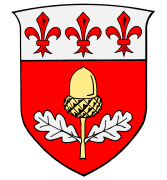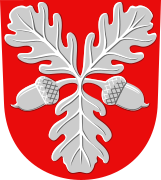Acorn

| Nutritional value per 100 g (3.5 oz) | |
|---|---|
| Energy | 1,619 kJ (387 kcal) |
40.75 g | |
23.85 g | |
| Saturated | 3.102 g |
| Monounsaturated | 15.109 g |
| Polyunsaturated | 4.596 g |
6.15 g | |
| Tryptophan | 0.074 g |
| Threonine | 0.236 g |
| Isoleucine | 0.285 g |
| Leucine | 0.489 g |
| Lysine | 0.384 g |
| Methionine | 0.103 g |
| Cystine | 0.109 g |
| Phenylalanine | 0.269 g |
| Tyrosine | 0.187 g |
| Valine | 0.345 g |
| Arginine | 0.473 g |
| Histidine | 0.170 g |
| Alanine | 0.350 g |
| Aspartic acid | 0.635 g |
| Glutamic acid | 0.986 g |
| Glycine | 0.285 g |
| Proline | 0.246 g |
| Serine | 0.261 g |
Niacin (B3) | 11% 1.827 mg |
| Pantothenic acid (B5) | 14% 0.715 mg |
| Vitamin B6 | 31% 0.528 mg |
| Folate (B9) | 22% 87 μg |
| Vitamin C | 0% 0.0 mg |
Copper | 69% .621 mg |
| Iron | 4% 0.79 mg |
| Magnesium | 15% 62 mg |
| Manganese | 58% 1.337 mg |
| Phosphorus | 6% 79 mg |
| Potassium | 18% 539 mg |
| Sodium | 0% 0 mg |
| Zinc | 5% 0.51 mg |
| Other constituents | Quantity |
| Water | 27.9 g |
| †Percentages estimated using US recommendations for adults,[1] except for potassium, which is estimated based on expert recommendation from the National Academies.[2] | |
The acorn, or oaknut, is the
(occasionally two seeds), enclosed in a tough, leatheryEtymology
The word acorn (earlier akerne, and acharn) is related to the Gothic name akran, which had the sense of "fruit of the unenclosed land".[3] The word was applied to the most important forest produce, that of the oak. Chaucer spoke of "achornes of okes" in the 14th century. By degrees, popular etymology connected the word both with "corn" and "oak-horn", and the spelling changed accordingly.[4] The current spelling (emerged 15c.-16c.), derives from association with ac (Old English: "oak") + corn.[5]
Ecological role
Acorns play an important role in forest ecology when oaks are plentiful or dominant in the landscape.[6] The volume of the acorn crop may vary widely, creating great abundance or great stress on the many animals dependent on acorns and the predators of those animals.[7] Acorns, along with other nuts, are termed mast.
Wildlife that consume acorns as an important part of their diets include birds, such as
Large mammals such as pigs, bears, and
The larvae of some moths and weevils also live in young acorns, consuming the kernels as they develop.[16]
Acorns are attractive to animals because they are large and thus efficiently consumed or cached. Acorns are also rich in nutrients. Percentages vary from species to species, but all acorns contain large amounts of
Acorns also contain bitter
Animals that
Species of acorn that contain large amounts of tannins are very bitter,
Tannins can be removed by soaking chopped acorns in several changes of water, until the water no longer turns brown. Cold water leaching can take several days, but three to four changes of boiling water can leach the tannins in under an hour.[18] Hot water leaching (boiling) cooks the starch of the acorn, which would otherwise act like gluten in flour, helping it bind to itself. For this reason, if the acorns will be used to make flour, then cold water leaching is preferred.[19]
Being rich in fat, acorn flour can spoil or
Acorns of the white oak group, Leucobalanus, typically start rooting as soon as they are in contact with the soil (in the fall), then send up the leaf shoot in the spring.
Dispersal agents

Acorns are too heavy for
Many animals eat unripe acorns on the tree or ripe acorns from the ground, with no reproductive benefit to the oak, but some animals, such as squirrels and jays serve as seed dispersal agents. Jays and squirrels that scatter-hoard acorns in caches for future use effectively plant acorns in a variety of locations in which it is possible for them to germinate and thrive.
Even though jays and squirrels retain remarkably large mental maps of cache locations and return to consume them, the odd acorn may be lost, or a jay or squirrel may die before consuming all of its stores. A small number of acorns manage to germinate and survive, producing the next generation of oaks.
Scatter-hoarding behavior depends on jays and squirrels associating with plants that provide good packets of food that are nutritionally valuable, but not too big for the dispersal agent to handle. The beak sizes of jays determine how large acorns may get before jays ignore them.
Acorns germinate on different schedules, depending on their place in the oak family. Once acorns sprout, they are less nutritious, as the seed tissue converts to the indigestible lignins that form the root.[20]
Uses
In some cultures, acorns once constituted a dietary
Several cultures have devised traditional acorn-leaching methods, sometimes involving specialized tools, that were traditionally passed on to their children by word of mouth.[21][22]
Culinary use
Acorns served an important role in early human history and were a source of food for many cultures around the world.
In Korea, an edible jelly named
Acorns have frequently been used as a
respectively, are particularly notable past instances of this use of acorns.Use by Native Americans
Acorns are a traditional food of many
After drying in the sun to discourage mould and germination, acorns could be cached in hollow trees or structures on poles to keep them safe from mice and squirrels. Stored acorns could then be used when needed, particularly during the winter when other resources were scarce. Acorns that germinated in the fall were shelled and pulverized before those germinating in spring. [citation needed] Because of their high fat content, stored acorns can become rancid. Moulds may also grow on them.
The lighting of ground fires killed the larvae of
Fires also released the nutrients bound in dead leaves and other plant debris into the soil, thus fertilizing oak trees while clearing the ground to make acorn collection easier. Most North American oaks tolerate light fires, especially when consistent burning has eliminated woody fuel accumulation around their trunks. Consistent burning encouraged oak growth at the expense of other trees less tolerant of fire, thus keeping oaks dominant in the landscapes. [citation needed]
Oaks produce more acorns when they are not too close to other oaks and thus competing with them for sunlight, water and soil nutrients. The fires tended to eliminate the more vulnerable young oaks and leave old oaks which created open oak savannas with trees ideally spaced to maximize acorn production.
In culture
Art
A
.In the Artemis Fowl book series, "The Ritual" describes the method used by faeries to regenerate their magical powers.[29]
Military symbolism

The acorn was used frequently by both
Contemporary use as symbol
The acorn is the symbol for the
Acorns are also used as charges in heraldry.
-
Acorn waymark for National Trails
-
Acorn in the coat of arms of the du Quesne family
-
Oak branch with two acorns in the coat of arms of Tammela
See also
- Knopper gall
External links
References
- ^ United States Food and Drug Administration (2024). "Daily Value on the Nutrition and Supplement Facts Labels". Retrieved 28 March 2024.
- )
- ^ Harper, Douglas. "acorn". Online Etymology Dictionary.
- ^ One or more of the preceding sentences incorporates text from a publication now in the public domain: Chisholm, Hugh, ed. (1911). "Acorn". Encyclopædia Britannica. Vol. 1 (11th ed.). Cambridge University Press. pp. 152–153. This cites the New English Dictionary, now the Oxford English Dictionary
- ^ "Online Etymology Dictionary". etymonline.com. Retrieved 15 April 2017.
- ASIN B000PMY1P8.
- ^ King, Richie S. (2 December 2011). "After Lean Acorn Crop in Northeast, Even People May Feel the Effects". The New York Times. Retrieved 4 December 2011.
there is nothing unusual about large fluctuations in the annual number of acorns.
- ISSN 0307-6946.
- ^ "Acorn Study | Research | Upland Hardwood Ecology and Management | SRS". srs.fs.usda.gov. Retrieved 4 September 2020.
- ^ "Acorns fatally poison 50 ponies in English forest". Horsetalk.co.nz. 27 November 2013. Retrieved 6 January 2017.
- ^ "Acorn Poisoning – Are Acorns Poisonous To Horses?". Horse-advice.com. Retrieved 6 January 2017.
- ^ "Acorns, Oaks and Horses: Tannin Poisoning". The Way of Horses. 15 September 2002. Retrieved 6 January 2017.
- ^ Barrett, Reginald H. (1980). "Mammals of California Oak Habitats-Management Implications" (PDF). In Plumb, Timothy R. (ed.). Proceedings of the symposium on the ecology, management, and utilization of California oaks, June 26–28. USDA Forest Service General Technical Report PSW-044. pp. 276–291.
- ^ "A bumper crop of acorns causes concern for those with horses". Countryfile.com. Immediate Media Company. 19 October 2011. Retrieved 27 January 2014.
- ^ a b Barringer, Sam. "Acorns Can be Deadly". West Virginia University Extension Service. Archived from the original on 27 February 2014. Retrieved 27 January 2014.
- ^ Brown, Leland R. (1979) Insects Feeding on California Oak Treesin Proceedings of the Symposium on Multiple-Use Management of California's Hardwood Resources, Timothy Plum and Norman Pillsbury (eds.).
- ^ "Nutrition Facts for Acorn Flour". Nutritiondata.com. Retrieved 6 January 2017.
- OCLC 15015652.
- ^ "Two Ways to Make Cold Leached Acorn Flour – Learn How with this Guide". The Spruce. Retrieved 24 December 2017.
- JSTOR 2096937
- ^ "Indigenous Food and Traditional Recipes". NativeTech. Retrieved 6 January 2017.
- ^ "Cooking With Acorns". Siouxme.com. Retrieved 6 January 2017.
- ^ Bainbridge, D. A. (12–14 November 1986), Use of acorns for food in California: past, present and future, San Luis Obispo, CA.: Symposium on Multiple-use Management of California's Hardwoods, archived from the original on 27 October 2010, retrieved 1 September 2010
- ISBN 978-0-521-77670-7.
- ^ Alphonso, Christina (5 November 2015). "Acres of Acorns". The Metropolitan Museum of Art, i.e. The Met Museum. Retrieved 15 April 2017.
- ^ Derby, Jeanine A. (1980). "Acorns-Food for Modern Man" (PDF). In Plumb, Timothy R. (ed.). Proceedings of the symposium on the ecology, management, and utilization of California oaks, June 26–28. USDA Forest Service General Technical Report PSW-044. pp. 360–361.
- ^ Prichep, Deena (2 November 2014). "Nutritious Acorns Don't Have To Just Be Snacks For Squirrels". The Salt : NPR. Retrieved 3 November 2014.
- ISBN 9780670899623.
- ^ Forest Service, U.S. (27 October 2022). "Chikamauga and Chattanooga". Frequently Asked Questions. Retrieved 27 October 2022.
- ^ "National Trail Acorn". National Trails. Archived from the original on 14 March 2012. Retrieved 9 October 2010.
- ^ "University of Connecticut". Archived from the original on 4 November 2010. Retrieved 5 November 2010.



